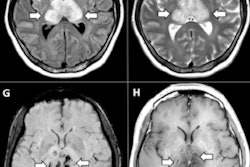
Artificial intelligence (AI)-based analysis of 3D SPECT exams can help physicians to determine a patient's stage of Parkinson's disease, according to research published online May 30 in Expert Systems and Applications.
Researchers from the University of Córdoba in Spain trained a deep-learning algorithm to evaluate a patient's potential presynaptic deficit on 3D SPECT images. In testing, the algorithm yielded a promising level of performance for classifying patients as either normal or in one of three other classes that indicate an increasing severity of brain damage.
The information generated by AI of 3D SPECT could potentially enable physicians to adjust a patient's treatment based on the severity of their disease, according to researchers led by Javier Barbero-Gómez.
"These methods could help doctors in the diagnosis and treatment of [Parkinson's disease] and other parkinsonisms through [decision-support systems] and contribute toward the relief of the public health cost of this disease," the authors wrote.
The researchers trained and tested two versions of a 3D convolutional neural network (CNN) to perform ordinal, or multiclass, classification using 508 3D SPECT images from the nuclear medicine department of the Hospital Reina Sofía in Córdoba, Spain. All patients in the study had received the ioflupane iodine-123 radiopharmaceutical prior to SPECT imaging and had been classified into one of four categories of disease severity based on the radiologist's assessment of the dopaminergic activity in the nigrostriatal dopaminergic pathway.
Of the 508 images, 314 (61.8%) were of healthy patients (class 0), while 41 (8.3%) had a slight alteration (class 1) to the nigrostriatal dopaminergic pathway. More advanced alteration (class 2) was seen in 52 (10.2%) patients and severe alteration (class 3) was evident in 100 (19.7%) of the images.
The radiologists' diagnosis for each of the images was attached as a class label and used to train the CNNs. Due to the imbalance in the training dataset, the researchers utilized data augmentation techniques in an effort to improve the performance of the algorithms.
The best-performing AI algorithm yielded a high area under the curve (AUC) for each of four classes of Parkinson's disease stage:
- Class 0 (normal): 0.936
- Class 1 (slight alteration to the nigrostriatal dopaminergic pathway): 0.729
- Class 2 (more advanced alteration to the nigrostriatal dopaminergic pathway): 0.850
- Class 3 (severe alteration to the nigrostriatal dopaminergic pathway): 0.910
"We have confirmed experimentally that the exploitation of ordinal information can improve the performance of a complex task such as the assessment of brain activity alteration in [Parkinson's disease]," the authors wrote. "This exploitation comes from aspects such as the model architecture, the optimization target, and the data augmentation strategy."
In related work published earlier this year in Scientific Reports, the group of researchers also shared initial efforts with an ordinal classification algorithm for classifying Parkinson's disease stages.
"... this work suggests a new option to approach [Parkinson's disease], with good values for diagnosis accuracy and classification in the different disease stages," the authors wrote in that study.
The researchers noted that their methodology could also be utilized in other ordinal image classification applications that are similarly challenged in assembling sufficiently balanced datasets.




















